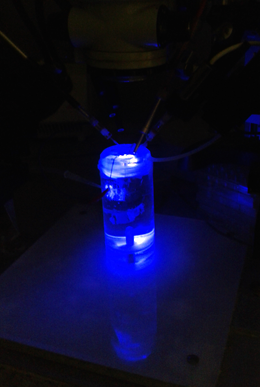Photosensitive version of amiloride allows regulating the function of sodium-specific ion channels with light

The diuretic agent amiloride is used for the treatment of high blood pressure. Ludwig Maximilian University of Munich researchers have now synthesized a photosensitive version, which allows regulating the function of sodium-specific ion channels with light.
Diuretics are pharmacological agents that increase the output of urine and are commonly used for the treatment of hypertension and heart failure. One of the best known potassium sparing diuretics – amiloride – blocks the action of so-called epithelial sodium channels (ENaCs), which have diverse physiological functions. ENaCs are heterotrimeric proteins that form channels in the cell membrane and allow the passage of sodium ions (Na+). In the kidney, the so-called alpha/beta/gamma subtype is involved in the resorption of sodium from the urine, which reduces water loss and maintains blood volume. In addition, ENaCs have been identified in non-epithelial tissue, for instance neurons, where their function is not as well understood. A team led by Dirk Trauner, Professor of Chemical Biology and Genetics at LMU, in collaboration with colleagues at Justus Liebig University in Giessen, has now modified the structure of amiloride in such a way that its action of blocking ENaCs can be controlled with light. This provides the first optical tool for an amiloride-sensitive ion channel.
"The new Photoamiloride allows us to control the activity of ENaCs by means of optical signals," says Matthias Schönberger, first author on the paper describing the work, which appears in the journal Nature Chemistry. Exposure to blue light activates the photoamiloride, which translates into a block of the ENaC. Turning off the light or irradiating the cells with green light alters the shape of the compound in such a way that the block is released and sodium ions flow through the channel pore into the cell. With this technique, the channel can be opened and closed at will.
Subtype selectivity
The researchers have shown that the novel photoamiloride functions in this way on ENaCs in amphibian cells as well as in human embryonal kidney cells and in a tissue-culture model of human lung epithelium. These experiments also revealed that the new inhibitor interacts most effectively with the delta/beta/gamma ENaC. This is an exciting finding, as agents selective for this ENaC subtype have so far been lacking, and its function is poorly understood. "We now have a tool at hand that allows investigating this particlular
channel isoform," Schönberger adds.
There has been much speculation that aberrant influx of sodium ions through ENaCs might contribute to the pathogenesis of neuronal diseases by causing persistent, uncontrolled firing by nerve cells. "At the moment, that is highly hypothetical – mainly because delta ENaCs are only found in primates. This has made their function very difficult to study, particularly in the brain. Therefore we are very happy that we now have a pharmacological tool that acts primarily on this type of channel," Schönberger explains.
Thus, the new photoamiloride not only allows ENaCs to be controlled by light, it also allows dissecting the functions of different ENaC subtypes. This should lead to a better understanding of the roles of these channels in different tissues. And that's not all. "In addition, our photoamiloride/ENaC system can be used to manipulate the polarization state of cells – the magnitude of the electrical potential across the cell membrane – by altering the flow of sodium ions through these channels," Dirk Trauner adds. "Based on this approach, it should be possible to develop an optically based screening platform for voltage-sensitive ion channels. Furthermore, the new compound provides us with a novel means of studying how polarization-based intercellular communication systems work."
More information: "Controlling epithelial sodium channels with light using photoswitchable amilorides." Matthias Schönberger, et al. Trauner. Nature Chemistry (2014) DOI: 10.1038/nchem.2004. Received 07 May 2013 Accepted 12 June 2014 Published online 20 July 2014
Journal information: Nature Chemistry
Provided by Ludwig Maximilian University of Munich



















